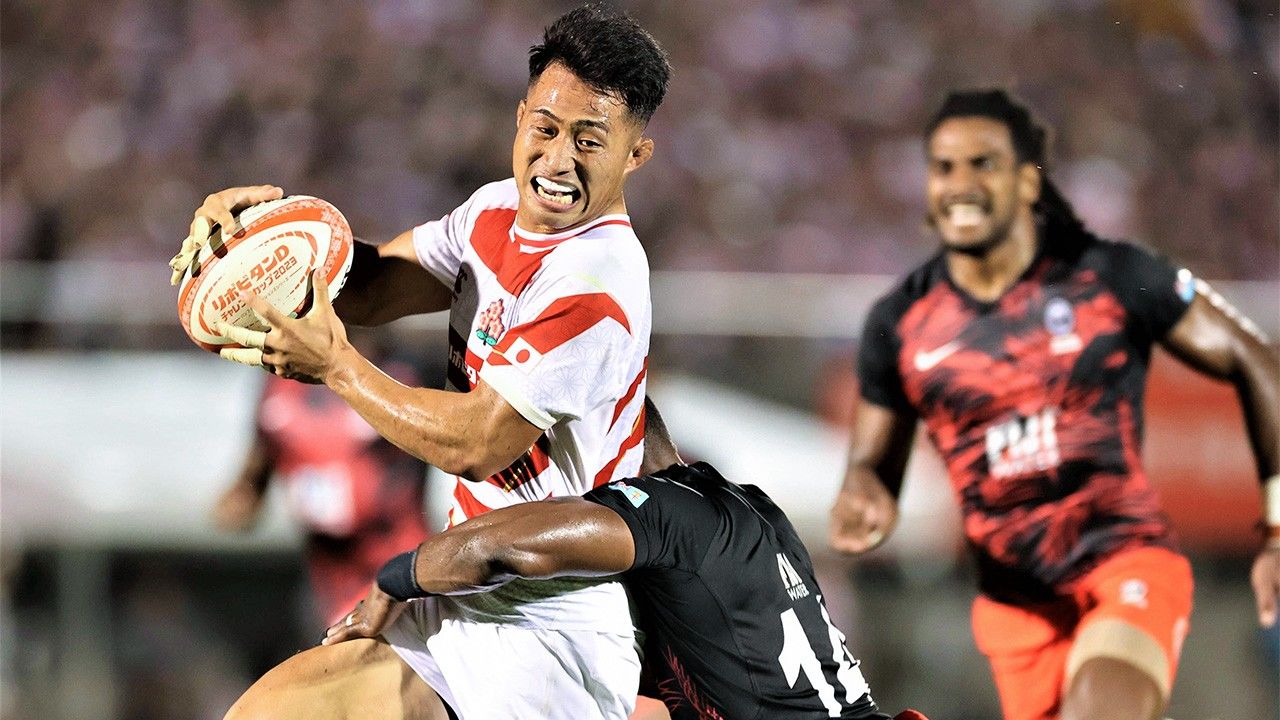
Osada Tomoki: Versatile Back Eyeing Tries at Rugby World Cup
Sports- English
- 日本語
- 简体字
- 繁體字
- Français
- Español
- العربية
- Русский
Japanese Rugby’s Cinderella Man
For Osada Tomoki of Japan Rugby League One team Saitama Wild Knights, the 2022/23 season was a breakout year. A standout even among a squad packed with internationals from around the world, the 23-year-old center won rookie of the year honors for his performance and was also named to the league’s team of the year. And now, having been selected in Japan’s squad for Rugby World Cup 2023 in France, he is being hailed as something of a Cinderella story.
While this summer saw Osada start on the bench in Japan’s early home fixtures at the Pacific Nations Cup international friendly tournament held as a World Cup warm-up, he played the full 80 minutes in the Brave Blossoms’ fourth game, against Tonga. Despite his relatively small 179-centimeter, 90-kilogram frame, he gave no quarter against the Pacific Islanders’ hulking front row of 120 kilogram-plus forwards.
In the next matchup, against a fleet-footed Fiji side, he again caught the eye as he drove his team forward with a mazy 70-meter run. And even after a red card reduced Japan to 14 men, Osada displayed admirable positional awareness as he ran through to set up a try for teammate Jone Naikabula. “I’ve always played my rugby with a focus on how to lose my marker, so I was just acting on instinct,” he later recalled modestly.
A Proactive Style
Yet, despite an impact that belies his status as a rookie on the international stage, Osada insists that he does not see himself as a star. “I’ve never been blessed with the speed or physicality to dominate opponents,” he explains. “My attacking game is all about how to win ground by evading opposing players, while in defense I try to proactively plug the gaps they might aim to exploit. Those are the strengths I try to bring.” Stealthily moving across the field, Osada’s true forte is the way he allows his teammates to shine.
Born in Kyoto Prefecture, Osada took up rugby in junior high. After captaining Osaka’s Tōkai University Gyōsei High School to a national championship and earning a place in an all-Japan schoolboy 15, he went on to play for Waseda University, where, as a freshman, he established himself as a regular starter on the wing. In his sophomore year, Osada at center helped the team win the Japan university championships, and as a senior he was chosen as captain. But his real breakout would come in his first year with Saitama Wild Knights, where his ability to cope equally well with the demands of both wing and center would really come into its own.
Early on in his rookie season, Osada did not even make the substitutes’ bench, and his debut did not come until game five against Black Rams Tokyo, where he started at inside center. Three games later, against Hanazono Liners, he had moved to outside center, and in the next match against Kobe Steelers he came on as a sub on the wing. The following week against Spears Funabashi Tokyo Bay, he began a run of three consecutive try-scoring performances at right wing. He would go on to score four tries in the team’s final three regular-season matches and one in the league final against the Spears, even while being shuffled between center and wing.
“I don’t really have a preferred position,” Osada declares. “I’m better suited to playing center, but more than my own personal preferences, I want to fulfill whatever role the team requires of me.” And while these may sound like the words of a teacher’s pet, backing such comments up is another matter entirely, especially in a sport where the demands of individual positions are so different.
Inside center (number 12) pits players against the opposing defensive line, home to some of the most physically imposing specimens in world rugby. Outside center (number 13), meanwhile, is one of the most technical positions in the sport, calling for a full repertoire of passes and kicks as players move quickly to close down opponents and eliminate defensive gaps on both flanks. And right wing (number 14) demands that players excel in both try scoring and prevention, receiving the ball wide to sprint toward the opposition goal line, and tracking back with last ditch tackles to snuff out rival breaks.
A Versatile Try-Scoring Back
Osada’s capacity to adapt to all three positions, delivering solid performances game after game no matter what number jersey he may be wearing, is nothing short of remarkable. Incidentally, of the nine tries he scored in his rookie season, two came from inside center, three from outside center, and four from full back, owing to intelligent movement that allows him to lose his marker and maintain scoring output regardless of where he plays.
His senior international debut against Tonga came at Hanazono Rugby Stadium, a familiar venue from his high school days, while the following game against Fiji took place at Chichibunomiya Rugby Stadium, another frequent stomping ground during his time at Waseda. And in both matches he played the full 80 minutes, spurred on by the home crowd. “In a typical game, half the fans are cheering you on and the other half are booing,” recalls Osada. “But at home games for Japan, it’s great to have all the supporters rooting for you.”
Similarly, at the Rugby World Cup, Osada is looking to put on a show for the discerning local supporters attending Japan’s Pool D games in the rugby-mad cities of Nice, Toulouse, and Nantes. And if he can manage to showcase his full versatility, he is sure to make fans of them, too.
(Originally published in Japanese. Banner photo: Osada Tomoki runs the ball against Fiji at Chichibunomiya Rugby Stadium in Tokyo on August 5, 2023. © Jiji.)